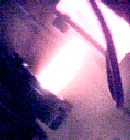
Pulsed Laser Ablation and Deposition (PLAD) has proved itself as a very efficient technique for producing films of virtually any kind of materials, including refractory ceramics. The technique is realized by focusing a pulsed UV-laser beam onto a solid target. Laser/material interaction leads to local vaporization of the material (ablation). The jet of ablated species, the so-called plume, can then be collected onto a suitable substrate, where the thin film can grow.
Advantages with respect to more traditional physical deposition methods (e.g., thermal evaporation, RF-sputtering, ion bombardment) are strictly related to the high efficiency of the coupling between the UV-laser pulse and the solid target. Moreover, thanks to the formation of a relatively hot and dense plasma following laser interaction, the plume exhibits a peculiar dynamics with a large kinetic energy associated to the motion in the direction orthogonal to the target surface. This promotes the occurrence of reactive-collisional processes during the plume expansion in the presence of a controlled atmosphere within the deposition chamber (typically, oxygen at a pressure in the tenths of mbar range). Such processes are important to achieve the correct stoichiometry in the deposited films, and favor the mobility of the deposited species on the substrate, essential to obtain epitaxial growth without the need for any post-deposition ex-situ treatment.
Since from the beginning
of our activity in the field of PLAD, more than ten years ago, we have
been interested in both applying the technique to fabrication of thin films
and multilayers of innovative materials and in diagnosing the process by
using methods typical of atomic and molecular phsyics.
The research activity is supported by CNR through specific
Research Projects.
You can visit our
site by clicking on the left menu.
Address
INFM, Dipartimento
di Fisica, Università di Pisa
Via F. Buonarroti
2, I-56127 Pisa, Italy
Tel. +39 050 2214
293, 305
Fax +39 050 2214
333